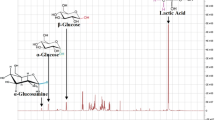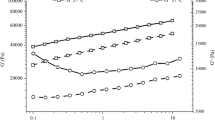Summary
Immobilized cell technology was used to prepare concentrated cultures ofLactococcus lactis that lost only 22% of viability over a 30-day storage period at 4°C. Concentrated cultures ofL lactis CRA-1 were immobilized in calcium alginate beads and added to glycerol, NaCl or sucrose-NaCl solutions in order to obtain aw readings ranging from 0.91 to 0.97. The suspensions were subsequently placed at 4°C and viability (CFU g−1 of bead) was followed during storage. Viability losses were high at aw readings of 0.95 and 0.97 and pH dropped significantly (up to one unit) in the unbuffered solutions. Addition of 1% soytone or glycerophosphate helphed stabilize pH, and a beneficial effect on viability during storage was observed in the glycerol-soytone mix when the beads were added to the conservation solutions immediately following immobilization. When beads were added to the conservation solution immediately following immobilization, a 70% drop in cell counts occurred during the first 5 days of incubation. Dipping theL lactis-carrying beads in milk for 2h before mixing with the glycerolsoytone 0.93 aw solution reduced this initial 5-day viability loss. Cultures grown in the alginate beads also had good stability in the 0.93 aw glycerol-soytone solution, where 78% of the population was viable after 30 days at 4°C. The process could be used to store immobilized cells at a processing plant, or by suppliers of lactic starters who wish to ship cultures without freezing or drying.
Similar content being viewed by others
References
Andrews, W.E. 1989. Methods for recovering injured classical enteric pathogenic bacteria from foods. In: Injured Index and Pathogenic Bacteria: Occurrence and Detection in Foods, Water and Feeds, pp. 55–114. CRC Press, Boca Raton, FL.
Audet, P., C. Paquin and C. Lacroix. 1991. Effect of medium and temperature of storage on viability of lactic acid bacteria immobilized K-carrageenan-locust bean gum gel beads. Biotechnol. Techniques 5: 307–312.
Boyaval, P., A. Lebrun and J. Goulet. 1985. Étude de l'immobilisation deLactobacillus helveticus dans des billes d'alginate de calcium. Le Lait 65: 185–199.
Champagne, C.P., C. Baillargeon-Côté and J. Goulet. 1989. Whey fermentation by immobilized cells ofPropionibacterium shermanii. J. Appl. Bacteriol. 66: 175–184.
Champagne, C.P., F. Girard and N. Rodrigue. 1993. Production of concentrated suspensions of thermophilic lactic acid bacteria in calcium-alginate beads. Int. Dairy J. 3: 257–275.
Chen, S.L. and M. Chiger. 1985. Production of baker's yeast. In: Comprehensive Biotechnology, Vol. 3 (Moo-Young, M., ed.), pp. 429–462, Pergamon Press, London.
Harvey, R.J. 1965. Damage toSteptococcus lactis resulting from growth at low pH. J. Bacteriol. 90(5): 1330–1336.
Larsen, R.F. and M.C. Añón. 1989. Effect of water activity aw of milk on acid production bySteptococcus thermophilus andLactobacillus bulgaricus. J. Food Sci. 54(4): 917–921.
Linko, P. 1985. Immobilized lactic acid bacteria. In: Enzymes and Immobilized Cells in Biotechnology, pp. 25–36, The Benjamin/Cummings Publs. Co. Menlo Park, CA.
Martin, S.E. 1989. Detection ofStaphylococcus aureus from foods. In: Injured Index and Pathogenic Bacteria: Occurrence and Detection in Foods, Water and Feeds, pp. 133–146, CRC Press, Boca Raton, FL.
Pearce L.E., S.A. Brice and A.M. Crawford. 1973. Survival and activity of lactic streptococci following storage at 22°C and 4°C. N.Z. J. Dairy Sci. Technol. 4: 41–45.
Prevost, H. and C. Divies. 1988. Continuous pre-fermentation of milk by entrapped yoghurt bacteria. I. Development of the process. Milchwissenschaft 43(10):621–625.
Ross, G.D. 1980. Observation on the effect of inoculum pH on the growth and acid production of lactic streptococci in milk. Austral J. Dairy Technol. 35(12): 147–149.
Sheu, T.Y., R.T. Marshall and H. Heyman. 1993. Improving survival of culture bacteria in frozen desserts by microentrapment. J. Dairy Sci. 76: 1902–1907.
Thunell, R.K. 1988. pH controlled starters: a decade reviewed. Cult. Dairy Prod. J. 23: 11–16.
Tramper, J. 1990. In: Physiology of Immobilized Cells (de Bont, J.A.M., Visser, J., Mathiasson, B. and Tramper, J., eds), pp. 1–14, Elsevier., Amsterdam.
Troller, J.A. and J.V. Stinson. 1981. Moisture requirements for growth and metabolite production by lactic acid bacteria. Appl. Environ. Microbiol. 42(4): 682–687.
Author information
Authors and Affiliations
Rights and permissions
About this article
Cite this article
Champagne, C.P., Gardner, N. & Dugal, F. Increasing the stability of immobilizedLactococcus lactis cultures stored at 4 °C. Journal of Industrial Microbiology 13, 367–371 (1994). https://doi.org/10.1007/BF01577221
Received:
Accepted:
Issue Date:
DOI: https://doi.org/10.1007/BF01577221




